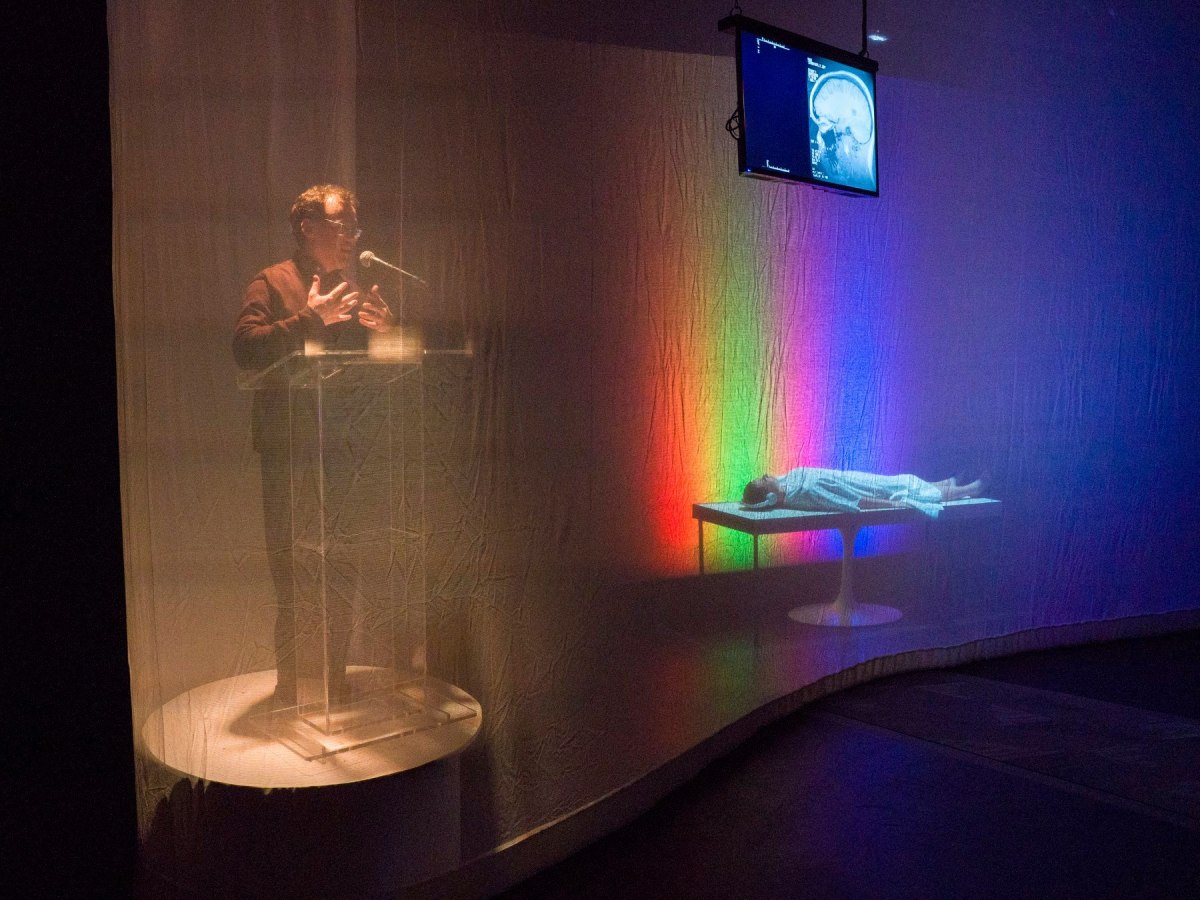Artistic director Eric Einhorn describes his Untitled Theater Company #61 as a “Theater Of Ideas: Scientific, political, philosophical, and above all theatrical.” In the capacities of producer, director, and especially playwright, Einhorn has a strong background in theatrical work that pursues these ideas. A keen interest in neuroscience and its theatrical possibilities also saw him contribute heavily to the “emergence of neuro-theatre.” Hot off the success of his last intellectual dramedy on Gertrude Stein, Einhorn pens The Neurology Of The Soul, which sees this love of neuroscience explore the neuroscience of love.
“I love you,” says Stephen, a cognitive neuroscientist, as his wife Amy lies in the fMRI (functional magnetic resonance imagery). “Sexy,” he continues, watching how each of his words lands in his wife’s mind. It is a live experiment conducted on the brain to determine the patterns and circuits of love “reactions”; to find out how people, or at least how Amy, ticks.
Enter Mark, the smooth-talking head of a neuro-marketing firm, who convinces Stephen to take a job applying his research to advertising. Mark sees the marketing potential in quantifying love way beyond Stephen understanding Amy, but that doesn’t mean he’s completely overlooked her. When Amy, an artist whose career has stalled, is inspired to make multimedia art from her brain scan records, Mark steps in to help jumpstart her career, to growing suspicion from Stephen.
Eric Einhorn’s dissertational script demonstrates copious research on the matter of cognitive neuroscience. Neuroscientist Stephen Macknik spoke in his talkback about the scientific nature of fMRIs, in which blood oxygenation is studied for trends. Which is about as precise as it gets; blood oxygenation occurs based on the movement of neurons, at which level very little discernible change happens—which means these trends are far from conclusive. That Stephen makes such concrete interpretations of Amy’s brain definitely leans more towards fiction than science. Which corroborates Einhorn’s intent of “filling the gap between pure scientific analysis and what it means to us all as humans.”
That said, the play may hold up to scientific scrutiny, but from a theatrical standpoint, Neurology feels like Einhorn coloring in a thesis with a narrative, and the drama he tries to infuse to it makes for an uneven blend at best, and in some moments even undermines the science. It is appreciably difficult to write love triangles, but they require three-dimensional and authentically motivated plots and characters. All four of Neurology’s talented cast struggle to accordingly flesh out soulless roles. Mick O’ Brien, whose Mark’s main function in the narrative seems to be a mouthpiece for Einhorn’s marketing research, affects a convincing corporate air, but is too often reduced to “talk, talk, talk,” even if his Powerpoint presentation monologues sometimes lend exposition to Amy and Stephens’ lives. His own character is obscured until the third act. Matthew Trumbull’s Stephen similarly lacked a human element, but for Trumbull’s acting chops, it follows that Stephen still has his moments. Ashley Griffin, a character actress known for bravura performances in nuanced female leads, is stuck here in a plot-driven drama with a plot that barely drives, and affords her character even less agency. Yvonne Roen’s Claire is an interesting exception: Though written as a caricature, the fact that her character does not contribute to the stagnation of the plot gives Roen much more freedom to excel in scenes, and she does. Her timing and delivery were always conducive to the energy of the scenes she occupied, and there are glimpses of a subtle empathy in her towards the end for which I credit the actress alone.
Lastly, I would be remiss not to mention the architects of Neurology, in which much of the show’s soul is found. Big points to Jim Boutin, Magnus Pind Bjerre, and Jeff Nash for set, video, and lighting that yields a product of alchemic cohesion, which sound designer Sadah Espii Proctor contributes to with the most creative of choices.

